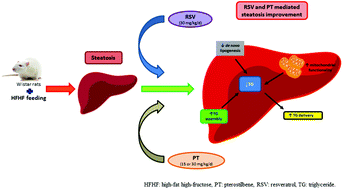Pterostilbene modifies triglyceride metabolism in hepatic steatosis induced by high-fat high-fructose feeding: a comparison with its analog resveratrol
Abstract
The use of phenolic compounds as a new therapeutic approach against NAFLD has emerged recently. In the present study, we aim to study the effect of pterostilbene in the prevention of liver steatosis developed as a consequence of high-fat (saturated) high-fructose feeding, by analysing the changes induced in metabolic pathways involved in triglyceride accumulation. Interestingly, a comparison with the anti-steatotic effect of its parent compound resveratrol will be made for the first time. Rats were distributed into 5 experimental groups and fed either a standard laboratory diet or a high-fat high-fructose diet supplemented with or without pterostilbene (15 or 30 mg per kg per d) or resveratrol (30 mg per kg per d) for 8 weeks. Serum triglyceride, cholesterol, NEFA and transaminase levels were quantified. Liver histological analysis was carried out by haematoxylin–eosin staining. Different pathways involved in liver triglyceride metabolism, including fatty acid synthesis, uptake and oxidation, triglyceride assembly and triglyceride release, were studied. Pterostilbene was shown to partially prevent high-fat high-fructose feeding induced liver steatosis in rats, demonstrating a dose–response pattern. In this dietary model, it acts mainly by reducing de novo lipogenesis and increasing triglyceride assembly and release. Improvement in mitochondrial functionality was also appreciated. At the same dose, the magnitude of pterostilbene and resveratrol induced effects, as well as the involved mechanisms of action, were similar.



 Please wait while we load your content...
Please wait while we load your content...